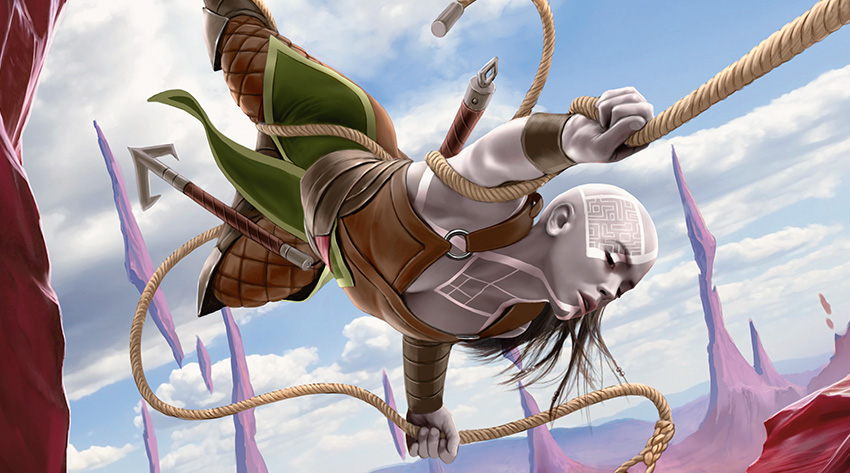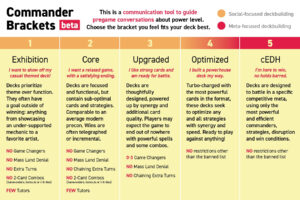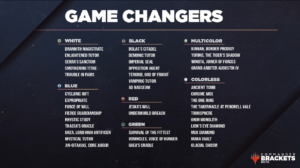Bracketology: Tweaking Your Decks for the Upgraded Bracket (3)

Akiri, Line-Slinger by David Gaillet
Welcome to Bracketology, a miniseries where I take existing Commander decks and see how they can fit into the newly announced Commander Brackets. This week, I'll be looking at two of my personal decklists and proposing some tweaks and substitutions to get them to match the game experience of the Upgraded bracket as described by Wizards.
For those of you who missed the announcement, the Commander Format Panel announced a beta trial of a new system to "create a common language to help people find well-paired games" consisting of five brackets:

Personally, I've had far too many "my deck is a seven" or "it's a lightly upgraded precon" Rule Zero conversations at my local game store, so these Commander Brackets offer a breath of fresh air. While I don't think they're perfect by any means (I think it's really hard to quantify the power level of highly synergistic decks), it's good to see that the Commander Format Panel is giving us a new tool to aid in pregame conversations.
The Upgraded Bracket (3)
I decided to start this series with the Upgraded Bracket (3) because it's where I imagine a good number of casual Commander players will end up. This bracket seems tailor-made for both homemade decks and upgraded versions of preconstructed decks.
The announcement article describes Upgraded decks as "souped up and ready to play beyond the strength of an average preconstructed deck" and notes that games "tend to be a little faster as well, ending a turn or two sooner than your Core (Bracket 2) decks. This also is where players can begin playing up to three cards from the Game Changers list, amping up the decks further."
The Game Changes list definitely complicates things further; it's a list of 40 (currently, anyways) cards that "dramatically warp Commander games, allowing players to run away with resources, shift games in ways that many players dislike, block people from play, efficiently search for their strongest cards, or have commanders that tend to take away from more casual games." Here's the list as shared in the announcement article:

It'll definitely be interesting to see how the Game Changers list evolves over time. There are some cards, like Necropotence
The Game Changers definitely make building a deck with the new brackets more complicated, because they're an additional 40 cards to keep in mind in addition to the Commander Banned List, but they do help us begin to navigate the muddy waters between a game of all preconstructed decks and a cEDH pod. Let's dive into this week's decklists:
Deck #1: Akiri, Line-Slinger / Keskit, the Flesh Sculptor Artifact Tokens
For our first decklist this week, we're looking at my personal Akiri/Keskit Artifact Tokens list. The deck itself cares about getting a lot of artifacts, be they tokens or real cards, with cards like Academy Manufactor
It's always been a deck that I've struggled to categorize in terms of power level because it can get out to explosive starts with cards like Urza's Saga
I was also running two Game Changer cards in it when the brackets were announced: Bolas's Citadel
Because it's running two Game Changers, this deck falls into the Upgraded Bracket (3) naturally without any changes. Removing Bolas's Citadel
Instead, I'm going to lean into the deck's aggressive playstyle a little more. The first thing I did was add a third Game Changer to the list. I ultimately settled on adding Trouble in Pairs
Smothering Tithe
I could have opted to play my existing decklist as-is, but I'm trying to better distinguish my decks into brackets for now, so I opted to power the deck up and see if it can hang with other decks that fall into the Upgraded Bracket (3).
The next thing I did to help power this deck up just a bit was tweak the lands. By replacing lands that enter tapped, like Canyon Slough
I did opt to add both Mox Opal
Finally, I opted to add in Aetherflux Reservoir
Overall, I think the revised decklist will be able to operate slightly more consistently and quickly and has an additional compact win condition compared to my original list. By changing about ten cards, I think this list now falls clearly into the Upgraded Bracket (3), but I'd be curious to hear your thoughts and other tweaks I should make in the comments below.
Deck #2: Chatterfang, Squirrel General Token Aristocrats
For our second decklist this week, we're going to look at my Chatterfang, Squirrel General token aristocrats decklist. This is a deck that loves to make a ton of tokens using Scute Swarm
My original list doesn't run any Game Changers, but it does have multiple dedicated tutors and has always been able to hang with decks that at least appear more powerful in the abstract. It runs a handful of three card combos, many of which use Chatterfang, and I've always found that it played too powerfully for casual pods, so I'm going to make a few small tweaks to make sure it falls solidly in the Upgraded Bracket (3).
There are three Game Changers I'm looking at potentially adding: Ad Nauseam
The deck was designed to have a lands sub-theme, so adding Glacial Chasm
Similarly, I also tweaked the deck's land base to be more streamlined and efficient. I added in eight fetch lands, like Prismatic Vista
Here's the revised decklist if you want to take a look. Compared to my original list, it seems like it'll still be very grindy, token-centric, and win with aristocrats-style cards, but it'll be a touch faster thanks to the upgraded manabase and have some powerful card draw to help close out the game. Part of me thinks this deck might be closer to an Optimized decklist, but only time and testing will tell.
How to Apply this to Your Own Decks
In going through this exercise, there were a handful of takeaways I came across that I'd recommend when optimizing your deck for the Upgraded Bracket (3):
Choose your Game Changers - I don't think every Upgraded deck must run three Game Changers, but I think it's a resource available to us in this bracket and will clearly define a deck's power level.
Review your win conditions - In this bracket, games can end "out of nowhere" after around turn six and can include infinite combos, so you'll want to make sure your deck has the ability to quickly and/or reliably end the game some amount of the time with something like Aetherflux Reservoir
Pivot off of mass land denial - If you love Blood Moon
Limit the extra turns - It seems clear that the Commander Format Panel wants to ensure every player gets a chance to play the game at the Upgraded Bracket (3), so if you're running extra turn spells, consider switching to cards like Alrund's Epiphany
Look at optimizing your manabase - Being able to reliably hit your colored mana sources is one of the best ways to upgrade a preconstructed deck, so it's definitely on the table for Upgraded decks.
Till Next Time
For the next article in this series, I'm looking to adapt decklists for the Core Bracket (2). I have a couple of my own lists that I think fall into that bracket or can be tweaked to fit, but I'd love to hear from you about the changes you're making to your own personal lists that you're looking to adapt for the Core Bracket (2).
Here's a quick recap of what decks in the Core Bracket (2) look like: "The power level of the average modern-day preconstructed deck sits here. No Game Changers, two-card combos, or mass land denial. You shouldn't expect to be chaining extra turns together. Tutors should be sparse."
I hope you found this experiment in tweaking my decklists to fit the new Brackets system helpful! I believe it's really important to think through the choices we make in our decklists to help them fall into a particular bracket or power level, and that doing so can help us better describe what our decks due to enable better Rule Zero conversations.
Let me know in the comments below what tweaks you're making to either power up or power down your decks to fit them into the Upgraded Bracket (3). I'm also curious to hear what other changes you'd make to the two decks I featured this week to help it fit into the new bracket system.